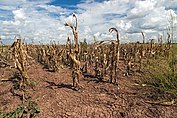A drought is a period of drier-than-normal conditions.[1]: 1157 A drought can last for days, months or years. Drought often has large impacts on the ecosystems and agriculture of affected regions, and causes harm to the local economy.[2][3] Annual dry seasons in the tropics significantly increase the chances of a drought developing, with subsequent increased wildfire risks.[4] Heat waves can significantly worsen drought conditions by increasing evapotranspiration.[5] This dries out forests and other vegetation, and increases the amount of fuel for wildfires.[4][6]
Drought is a recurring feature of the climate in most parts of the world, becoming more extreme and less predictable due to climate change, which dendrochronological studies date back to 1900. There are three kinds of drought effects, environmental, economic and social. Environmental effects include the drying of wetlands, more and larger wildfires, loss of biodiversity.
Economic impacts of drought result due to negative disruptions to agriculture and livestock farming (causing food insecurity), forestry, public water supplies, maritime navigation (due to e.g.: lower water levels), electric power supply (by affecting hydropower systems) and impacts on human health.[7]
Social and health costs include the negative effect on the health of people directly exposed to this phenomenon (excessive heat waves), high food costs, stress caused by failed harvests, water scarcity, etc. Drought can also lead to increased air pollution due to increased dust concentrations and wildfires.[8] Prolonged droughts have caused mass migrations and humanitarian crisis.[9][10]
Examples for regions with increased drought risks are the Amazon basin, Australia, the Sahel region and India. For example, in 2005, parts of the Amazon basin experienced the worst drought in 100 years.[11][12] Australia could experience more severe droughts and they could become more frequent in the future, a government-commissioned report said on July 6, 2008.[13] The long Australian Millennial drought broke in 2010. The 2020–2022 Horn of Africa drought has surpassed the horrific drought in 2010–2011 in both duration and severity.[14][15] More than 150 districts in India are drought vulnerable, mostly concentrated in the state of Rajasthan, Gujarat, Madhya Pradesh and its adjoining Chhattisgarh, Uttar Pradesh, northern Karnataka and adjoining Maharashtra of the country.[16]
Throughout history, humans have usually viewed droughts as disasters due to the impact on food availability and the rest of society. People have viewed drought as a natural disaster or as something influenced by human activity, or as a result of supernatural forces.
- ^ Douville, H., K. Raghavan, J. Renwick, R.P. Allan, P.A. Arias, M. Barlow, R. Cerezo-Mota, A. Cherchi, T.Y. Gan, J. Gergis, D. Jiang, A. Khan, W. Pokam Mba, D. Rosenfeld, J. Tierney, and O. Zolina, 2021: Water Cycle Changes Archived 2022-09-29 at the Wayback Machine. In Climate Change 2021: The Physical Science Basis. Contribution of Working Group I to the Sixth Assessment Report of the Intergovernmental Panel on Climate Change [Masson-Delmotte, V., P. Zhai, A. Pirani, S.L. Connors, C. Péan, S. Berger, N. Caud, Y. Chen, L. Goldfarb, M.I. Gomis, M. Huang, K. Leitzell, E. Lonnoy, J.B.R. Matthews, T.K. Maycock, T. Waterfield, O. Yelekçi, R. Yu, and B. Zhou (eds.)]. Cambridge University Press, Cambridge, United Kingdom and New York, NY, USA, pp. 1055–1210, doi:10.1017/9781009157896.010.
- ^ Living With Drought Archived 2007-02-18 at the Wayback Machine
- ^ Australian Drought and Climate Change Archived 2018-07-26 at the Wayback Machine. Retrieved June 7th 2007.
- ^ a b Brando, Paulo M.; Paolucci, Lucas; Ummenhofer, Caroline C.; Ordway, Elsa M.; Hartmann, Henrik; Cattau, Megan E.; Rattis, Ludmila; Medjibe, Vincent; Coe, Michael T.; Balch, Jennifer (30 May 2019). "Droughts, Wildfires, and Forest Carbon Cycling: A Pantropical Synthesis". Annual Review of Earth and Planetary Sciences. 47 (1): 555–581. Bibcode:2019AREPS..47..555B. doi:10.1146/annurev-earth-082517-010235. ISSN 0084-6597.
- ^ Merzdorf, Jessica (July 9, 2019). "A Drier Future Sets the Stage for More Wildfires". Climate Change: Vital Signs of the Planet. NASA.
- ^ Cite error: The named reference
Hartmannwas invoked but never defined (see the help page). - ^ Fleming-Muñoz, David A.; Whitten, Stuart; Bonnett, Graham D. (28 June 2023). "The economics of drought: A review of impacts and costs". Australian Journal of Agricultural and Resource Economics. 67 (4): 501–523. doi:10.1111/1467-8489.12527. ISSN 1364-985X.
- ^ Stanke, Carla; Kerac, Marko; Prudhomme, Christel; Medlock, Jolyon; Murray, Virginia (2013-06-05). "Health Effects of Drought: a Systematic Review of the Evidence". PLOS Currents. 5: ecurrents.dis.7a2cee9e980f91ad7697b570bcc4b004. doi:10.1371/currents.dis.7a2cee9e980f91ad7697b570bcc4b004 (inactive 1 November 2024). ISSN 2157-3999. PMC 3682759. PMID 23787891.
{{cite journal}}: CS1 maint: DOI inactive as of November 2024 (link) - ^ Stanke, C; Kerac, M; Prudhomme, C; Medlock, J; Murray, V (5 June 2013). "Health effects of drought: a systematic review of the evidence". PLOS Currents. 5. doi:10.1371/currents.dis.7a2cee9e980f91ad7697b570bcc4b004 (inactive 1 November 2024). PMC 3682759. PMID 23787891.
{{cite journal}}: CS1 maint: DOI inactive as of November 2024 (link) - ^ Bellizzi, Saverio; Lane, Chris; Elhakim, Mohamed; Nabeth, Pierre (12 November 2020). "Health consequences of drought in the WHO Eastern Mediterranean Region: hotspot areas and needed actions". Environmental Health. 19 (1): 114. Bibcode:2020EnvHe..19..114B. doi:10.1186/s12940-020-00665-z. ISSN 1476-069X. PMC 7659048. PMID 33183302.
- ^ Cite error: The named reference
:4was invoked but never defined (see the help page). - ^ Cite error: The named reference
:5was invoked but never defined (see the help page). - ^ Cite error: The named reference
:6was invoked but never defined (see the help page). - ^ Dunne, Daisy (2022-10-26). "Analysis: Africa's unreported extreme weather in 2022 and climate change". Carbon Brief. Retrieved 2022-10-29.
- ^ "Horn of Africa Drought: Regional Humanitarian Overview & Call to Action". ReliefWeb. 2022-09-21. Retrieved 2022-10-29.
- ^ Cite error: The named reference
:9was invoked but never defined (see the help page).



